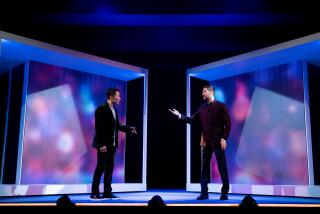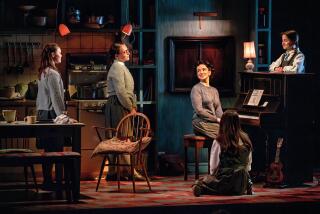‘The Climate’s’ Social Criticism Tracks Change in the National Weather
“I’ve been told by friends in New York that there is simply no traffic in or out of Wall Street during rush hours these days. It’s like a ghost town. Thousands are out of work.”
Jonathan Tolins relates this anecdote with a mixture of fascinated glee at the rapid change hitting the American economy, and sadness that it can hit so hard.
It’s this change in the national weather that he tracks in his play, “The Climate.” But Tolins’ blend of social criticism and human empathy lends the play a particular richness.
Tolins, sitting in Theatre/Theater’s microscopic rear theater with actress Dyanne DiRosario, with whom he performs “The Climate’s” nine, interrelated two-character scenes, was bringing up the Wall Street reference because one of his scenes has a young, unemployed Michael Milken wanna-be trying to pick up an editor at Mother Jones magazine in a singles bar.
“Until recently, we’ve thought that guys with outfits like Drexel, Burnham, Lambert have had it made,” Tolins says. “But this guy is desperate and lost. (“Climate” director Susan Snyder refers to him as “a well-dressed, homeless guy literally singing for his supper.”) Amy, the editor, first strikes us as cold, but then she sees his vulnerability.
“As a rule, I try not to judge the people I’m writing about.”
So, in a show that doesn’t hide its political concerns--the plight of gays and women are especially high on the agenda--the messages come through filters shaded in gray. DiRosario and Tolins credit Snyder for stressing the need to develop characters, and leave the urge for agitprop at the door.
Snyder explains: “One of the reasons I was attracted to the text in the first place was that the political content speaks for itself. It’s enough, for example in the ‘Mother and Son, Again’ scene, that the son be an anti-AIDS activist and mom can’t accept her son’s gay life. I told Jon and Dyanne that if, as actors, they are working moment to moment and let the characters speak for themselves, then the audience will find the politics for themselves. They should be allowed to think, since the message may be different for one person from another.”
Snyder might be speaking for herself and her collaborators, since “The Climate” is told predominantly from the point of view of people in their 20s, with the cultural reference points, fears and uncertainties that go with being young in the Age of Recession. Tolins is 24 and DiRosario is 26, whereas Snyder is 40.
“You have to be a certain age to remember ‘The Brady Bunch’s’ three-parter Hawaiian vacation show,” says DiRosario of one of her characters, Joy, who feels deprived that she never saw the show as a child. “We’re the first generation,” Tolins adds, “that realized that sex could have dire consequences, that we couldn’t frolic like the past generation could.”
Snyder, though, denies that the threesome experienced any generation gap. “Jon is 24 going on 60, and I’m 40 going on 18. Besides, his generation’s fear of AIDS is really a cover, I think, for a deeper problem--fear of intimacy. Fear of disease is a way of staying at arm’s length from another.”
Tolins confesses that he wanted someone older to direct his script, “especially a woman director.”
“We both did,” chimes in DiRosario.
“You see, I wrote my women characters from the outside looking in. But Dyanne and Susan worked closely to find their insides in a way I couldn’t.”
More problematic, though, was Tolins acting in his own script. DiRosario looks at Tolins, and doesn’t even try to hide her admiration: “Once rehearsals started, Jon stopped being the writer and became an actor. There was never any of that ‘Well, she would never say this.’ What mattered was what worked on stage.”
Tolins good-naturedly nods at the compliment and suggests that he doesn’t feel comfortable being in the position of The Playwright. “The key is finding the universal in the particular--aarrghh! I sound like I’m at some play-writing seminar. It is weird acting your own script, but the toughest thing was remembering the lines, because I kept thinking of earlier drafts.”
Tolins is more than equipped for “The Climate’s” rapidly changing gallery of people. He acted in several college production leads at Harvard, was in musicals at the school’s famed Hasty Pudding theater (his “Bye Bye Verdi” came out of his passion for opera), plus he acted in a week’s worth of performances in Robert Wilson’s American Repertory production of “the CIVIL warS.”
It was as a working actor that he met DiRosario, whose voice he had in mind as he wrote the play’s early drafts. “Well, it helped that I knew that she could play all of these types. I’ve seen that while studying with her in Al Mancini’s class at Beverly Hills Playhouse.” DiRosario then persuaded her classmate to join Theatre of NOTE in Hollywood, which is producing the ongoing theater-soap, “Lives of the Neo-Modern Fang People.”
The pair can be seen in two shows on back-to-back nights: Friday, in “The Climate,” then Saturday, in which DiRosario plays the town whore and Tolins plays physicist Bob in “Fang People.”
Mancini’s class formed the basis of “The Climate’s” last scene, where DiRosario’s actress--about to throw in the towel and move back home--is cajoled back into her artistic calling by Tolins’ tough but caring director-teacher. DiRosario says “this tiny space puts us in extremely close contact with the audience. And when, on one night, a lot of Al’s students were here. . . . “
Before DiRosario can finish her thought Tolins picks it up: “They’re hearing me say to Dyanne, ‘Why do we (as actors) do what we do?’ And all these actors in the audience are hanging on to every word, thinking to themselves, ‘Please tell me, so I can explain it to my parents!’ ”
The answer is similar to what William Faulkner said about writers doing what they do because they must. It’s the anthem of the misunderstood outsider.
“The show,” Tolins reflects, “is really for anyone who’s ever felt being an outsider, because that is who it addresses. Right now, in this culture, it is the outsiders who are most at risk.”
More to Read
The biggest entertainment stories
Get our big stories about Hollywood, film, television, music, arts, culture and more right in your inbox as soon as they publish.
You may occasionally receive promotional content from the Los Angeles Times.










